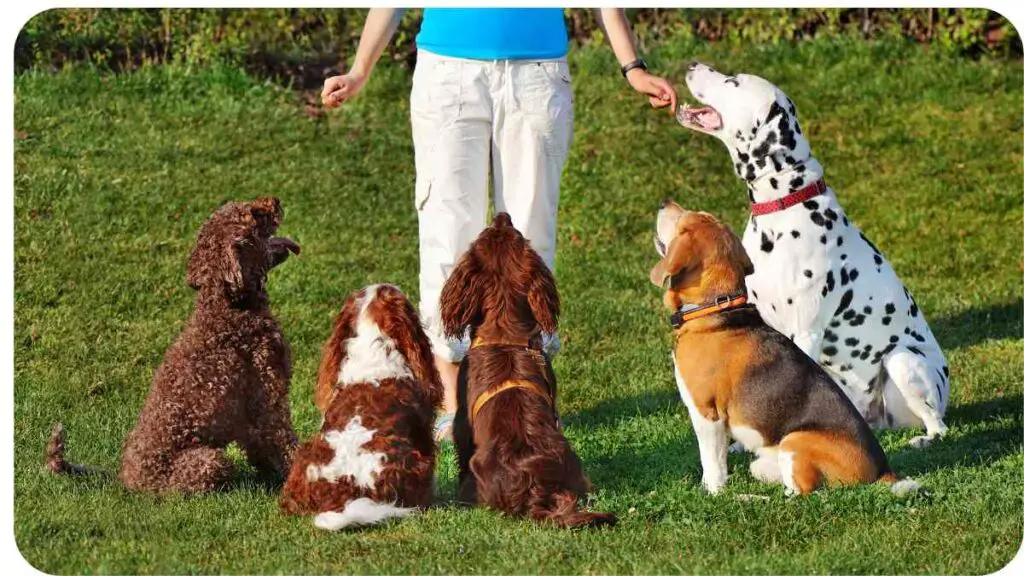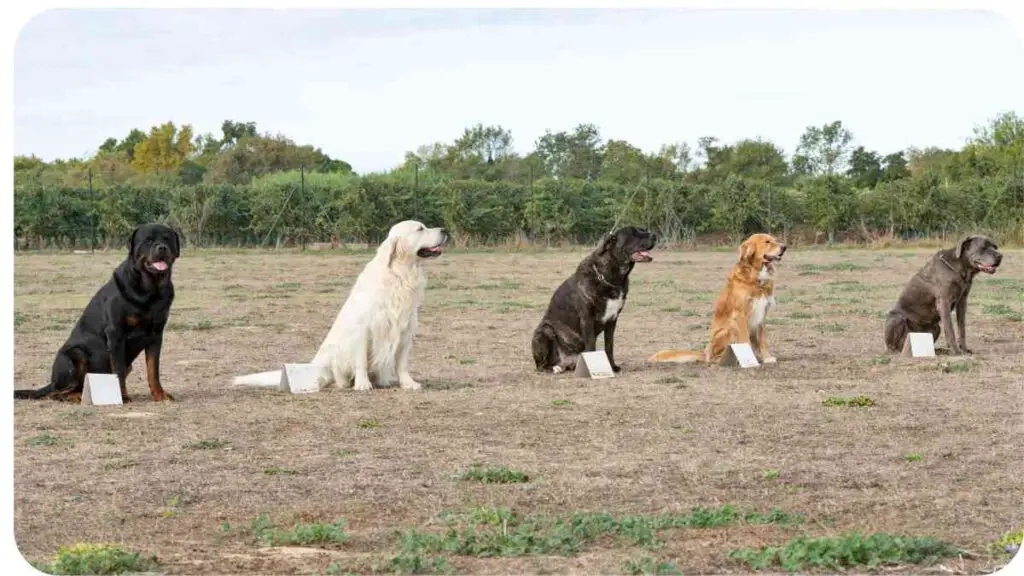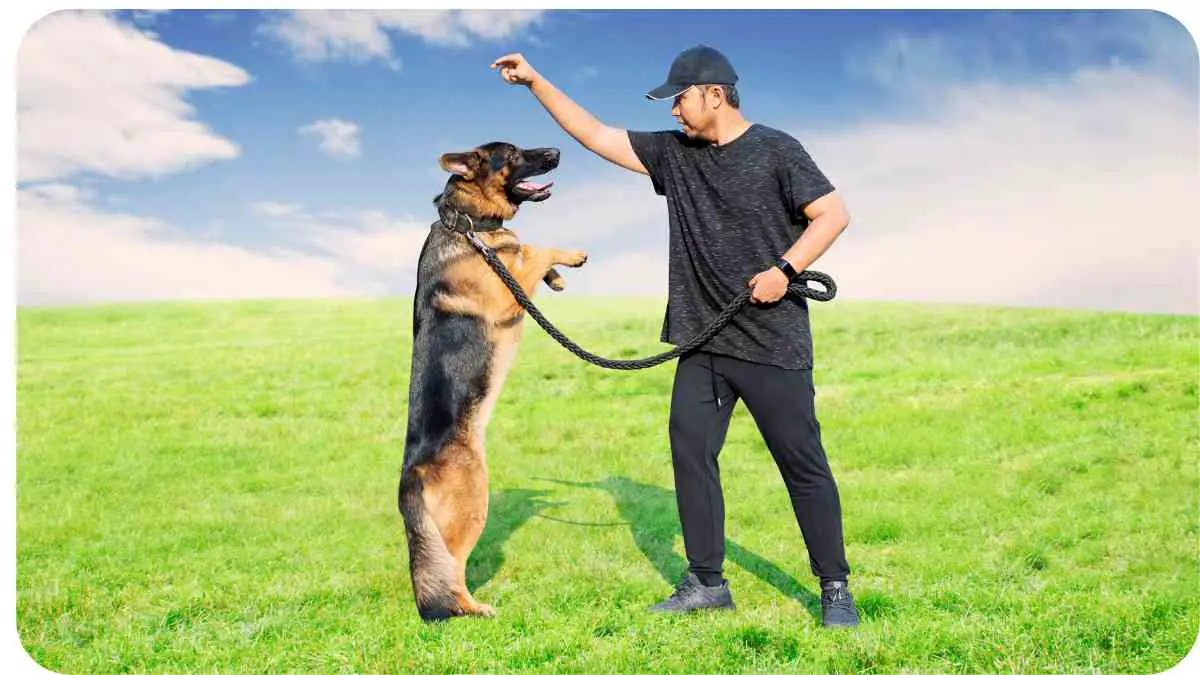When it comes to dog training, you’ve probably heard of a variety of styles and certifications, but PSA might be a new one for you. PSA stands for Protection Sports Association.
It’s a competitive dog sport that tests a dog’s obedience, protection skills, and their ability to handle high-stress situations. Think of it as the Olympics for protection dogs, where they show off their ability to follow commands, protect their handler, and respond to various scenarios.
| Key Takeaways |
|---|
| PSA stands for Protection Sports Association, a dog sport focusing on obedience and protection skills. |
| PSA training emphasizes real-world scenarios, ensuring practical applications of a dog’s skills. |
| The sport has multiple levels: PSA PDC, PSA 1, PSA 2, and PSA 3, each with increasing difficulty. |
| Effective PSA training combines basic obedience, protection training, and scenario-based exercises. |
| Essential tools for PSA training include quality leashes, collars, bite suits, sleeves, toys, and rewards. |
| A strong bond between the handler and dog is crucial for successful PSA training. |
| Consistency, patience, and positive reinforcement are key to overcoming training challenges. |
| PSA training can be beneficial for personal protection, law enforcement, and military applications. |
| Joining PSA clubs and communities provides support, resources, and networking opportunities. |
| Continuous learning and adapting to new techniques are important for maintaining PSA training standards. |
History of PSA
PSA was founded in 2001 by Jerry Bradshaw and Joe Morris. Their goal was to create a sport that emphasized real-world protection skills. Unlike other dog sports that may focus on traditional obedience or agility, PSA is designed to test the practical application of a dog’s training in protection work. It’s a young sport compared to others, but it’s quickly gaining popularity worldwide.
Enhancing your dog’s training sessions can be fun and effective with the right tools. For instance, using the best ball throwers for active dogs can significantly improve their exercise and engagement.
Understanding PSA in Dog Training

Definition of PSA
PSA is a unique sport that blends obedience and protection work. It stands out because it incorporates real-life scenarios, ensuring that the training has practical applications. Dogs are not only judged on their ability to follow commands but also on their responsiveness in protection tasks like guarding their handler or apprehending a “bad guy” in a safe and controlled manner.
Components of PSA
PSA training is divided into two main components:
- Obedience: Dogs must demonstrate their ability to follow commands with precision and enthusiasm.
- Protection: Dogs must show their skills in protection work, including guarding, pursuing, and controlling a decoy or an agitator.
Benefits of PSA Training
Why choose PSA training for your dog? Here are a few reasons:
- Enhanced Obedience: Your dog will learn to follow commands with remarkable accuracy.
- Real-World Skills: The training prepares dogs for real-life protection scenarios.
- Mental Stimulation: PSA provides both physical and mental challenges, keeping your dog engaged and sharp.
- Stronger Bond: Training together strengthens the bond between you and your dog, building trust and mutual respect.
A healthy dog is more receptive to training. Ensuring proper care, such as effective treatments for heartworms, can help maintain their overall well-being and enhance their ability to learn.
The PSA Levels and Titles
PSA PDC (Protection Dog Certificate)
The PSA PDC is the entry-level title in PSA. It tests basic obedience and simple protection skills. It’s like earning a high school diploma before moving on to more advanced training. Dogs must perform exercises such as heeling, staying, and a basic protection scenario.
PSA 1
This is the first level of advanced PSA training. Dogs must demonstrate advanced obedience and protection skills, including more complex scenarios and higher levels of control. This level is challenging and requires a lot of dedication from both the handler and the dog.
PSA 2
PSA 2 takes it up another notch. Dogs must show even more advanced obedience and protection abilities, including off-leash control and more intense protection scenarios. This level is demanding and requires consistent and rigorous training.
PSA 3
The highest level in PSA, PSA 3, is incredibly challenging. Dogs must perform flawlessly in highly complex obedience and protection scenarios. Achieving this level is a testament to the dog’s and handler’s dedication, skill, and hard work.
PSA Training Techniques
Basic Obedience
Before diving into protection work, a solid foundation of obedience is crucial. This includes commands like sit, stay, down, and heel. Think of it as the ABCs of dog training – essential and foundational.
Protection Training
Protection training involves teaching dogs to guard, chase, and apprehend. It’s not about creating aggressive dogs but rather controlled and responsive protectors. Dogs learn to identify threats and respond appropriately, ensuring safety for their handlers.
Health issues can impact your dog’s training progress. Learn how to address problems like yeast infections on your dog’s paw to ensure they stay comfortable and focused.
Scenario-Based Training
What sets PSA apart is its focus on real-life scenarios. Dogs are trained to respond to various situations, from home invasions to carjackings. This type of training ensures that the dog can handle unexpected events with confidence and control.
PSA Training Tools and Equipment

Leashes and Collars
Quality leashes and collars are essential. They provide control and guidance during training sessions. Using the right equipment ensures that the dog remains safe and responsive.
Bite Suits and Sleeves
For protection training, bite suits and sleeves are crucial. They protect the trainer while allowing the dog to practice biting and holding techniques. It’s like a safety net for both the trainer and the dog.
Toys and Rewards
Positive reinforcement is key in PSA training. Toys and rewards keep the dog motivated and engaged. They serve as incentives for good behavior and successful training sessions.
Building a strong bond with your dog is key to successful training. Discover how memory gifts for dog lovers can celebrate and enhance your connection with your furry companion.
Table: Common PSA Training Tools
| Tool | Purpose |
|---|---|
| Leashes | Control and guidance |
| Collars | Control and guidance |
| Bite Suits | Protection during bite training |
| Bite Sleeves | Protection during bite training |
| Toys | Positive reinforcement |
| Rewards | Positive reinforcement |
The Role of a PSA Trainer
Skills and Qualifications
A PSA trainer needs a deep understanding of dog behavior and training techniques. They must be patient, observant, and skilled in handling various dog breeds. A good trainer adapts their methods to fit each dog’s unique personality and needs.
Training Methods
Effective training methods include positive reinforcement, consistency, and clear communication. It’s important to make training sessions enjoyable and rewarding for the dog.
Building Trust and Bond with Dogs
Building a strong bond with the dog is essential. This bond is based on trust and mutual respect. A well-bonded dog is more responsive and eager to please, making training more effective.
Common Challenges in PSA Training
Behavioral Issues
Dogs may exhibit behavioral issues like aggression or fear. Addressing these issues requires patience and skill. It’s important to identify the root cause and work on it gradually.
Consistency in Training
Consistency is key in PSA training. Dogs need regular practice to reinforce their skills. Inconsistent training can lead to confusion and slower progress.
Environmental Distractions
Training in different environments can be challenging. Dogs may get distracted by new sights, sounds, or smells. Gradual exposure to different settings helps them stay focused during training.
Proper grooming supports effective training and a happy dog. Find out which are the best claw clippers for dogs to keep your pet well-groomed and comfortable.
Preparing for PSA Trials
Training Schedules
A structured training schedule is essential for preparing for PSA trials. Regular sessions help reinforce skills and build the dog’s confidence.
Mock Trials
Simulating trial scenarios helps dogs and handlers prepare for the real thing. Mock trials provide a chance to practice under conditions similar to the actual event.
Mental Preparation for Handlers and Dogs
Mental preparation is crucial. Handlers need to stay calm and focused, and dogs should be conditioned to handle the pressure of trials. Confidence comes from thorough preparation and practice.
PSA Training Clubs and Communities
Finding a Club
Joining a PSA training club provides access to resources, experienced trainers, and a supportive community. Clubs often host trials, workshops, and training sessions.
Benefits of Joining a Community
Being part of a community offers numerous benefits. It provides motivation, support, and opportunities to learn from others. Networking with fellow trainers can lead to valuable insights and friendships.
Networking with Other Trainers
Connecting with other trainers allows for the exchange of ideas and experiences. Learning from each other’s successes and challenges enhances everyone’s training skills.
Real-World Applications of PSA Training
Personal Protection
PSA training is highly beneficial for personal protection. Trained dogs can guard homes, families, and property effectively. They are reliable and responsive protectors.
Law Enforcement
Many law enforcement agencies use PSA-trained dogs. These dogs assist in various tasks, including suspect apprehension, search and rescue, and drug detection.
Military Use
The military also benefits from PSA-trained dogs. They are used in operations requiring detection, protection, and pursuit skills. Their training makes them valuable assets in the field.
Success Stories in PSA Training
Notable PSA Dogs
There are many notable dogs in the PSA community. These dogs have achieved high levels of skill and recognition. Their stories inspire and motivate other trainers and handlers.
Stories from Trainers
Trainers often share stories of their experiences, challenges, and triumphs. These stories provide valuable insights and lessons for others in the PSA community.
Overcoming Challenges
Success in PSA training often involves overcoming significant challenges. These stories highlight the dedication, perseverance, and skill required to achieve high levels of training.
PSA vs. Other Dog Sports
Comparing PSA with IPO/Schutzhund
PSA and IPO/Schutzhund have similarities but also key differences. Both involve obedience and protection work, but PSA places more emphasis on real-world scenarios and practical applications.
Differences with Mondioring
Mondioring is another dog sport that focuses on obedience and protection. However, it differs from PSA in its approach and specific requirements. Understanding these differences helps trainers choose the right sport for their dogs.
Advantages of PSA
PSA offers unique advantages, including practical training, real-world applications, and a strong community. It’s a versatile and rewarding sport for both dogs and handlers.
Maintaining PSA Training Standards
Regular Practice
Regular practice is essential for maintaining PSA training standards. Consistent training helps reinforce skills and ensures readiness for trials and real-world applications.
Continuous Learning
Trainers and handlers should commit to continuous learning. Staying updated on new techniques, attending workshops, and learning from others keeps training effective and engaging.
Updating Techniques
As the field of dog training evolves, so should training techniques. Adapting to new methods and incorporating innovative approaches keeps training fresh and effective.
FAQs About PSA Training
What breeds are best suited for PSA?
Breeds like Belgian Malinois, German Shepherds, and Dutch Shepherds are commonly seen in PSA. However, any breed with the right temperament and drive can participate.
How long does it take to train a PSA dog?
Training duration varies based on the dog’s age, breed, and prior training. On average, it can take 1-2 years to prepare a dog for PSA trials.
Can any dog participate in PSA trials?
While certain breeds are more common, any dog can participate in PSA trials if they have the right drive, temperament, and training.
What are the costs involved in PSA training?
Costs can include training fees, equipment, trial entry fees, and travel expenses. It’s important to budget for these costs to ensure a successful training journey.
How can I get started in PSA training?
Start by finding a local PSA club or trainer. Attend workshops, meet other handlers, and begin training with your dog. Consistency and dedication are key.
Further Reading
For those interested in diving deeper into PSA training, here are some valuable resources:
- What is PSA?
This blog post from DogiZone provides a comprehensive overview of what PSA training entails and its benefits. - Protection Sports Association
The official website of the Protection Sports Association offers detailed information about PSA trials, rules, and membership. - Crown PSA
Crown PSA’s website includes valuable insights into PSA training, events, and tips for handlers and trainers.
FAQs About PSA Training
What is PSA in dog training?
PSA, or Protection Sports Association, is a competitive dog sport that tests a dog’s obedience and protection skills through real-world scenarios.
How is PSA training different from other dog sports?
PSA focuses on practical protection work and real-life scenarios, unlike other dog sports that may prioritize traditional obedience or agility.
Can any dog breed participate in PSA?
While breeds like Belgian Malinois and German Shepherds are common, any dog with the right temperament and drive can participate in PSA.
What are the key components of PSA training?
PSA training includes obedience and protection work, with an emphasis on real-world applications and scenario-based training.
How can I start PSA training with my dog?
To start PSA training, find a local PSA club or trainer, attend workshops, and begin consistent training with your dog to build the necessary skills and bond.

I am Dr Hellen James a veterinarian, pet lover, and writer. I have many years of experience caring for pets, including dogs, cats, birds, and fish (and even axolotls!). I love spending time with the animals in my life, especially when they are sick or need love.

